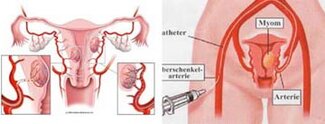Myoma Embolisation
Interventional radiology and treatmentThe Treatment of uterine myoma

Climacteric women can develop irregular or excessive menstrual bleeding. This problem is often associated with pain in the pelvic region and a decrease in the haemoglobin value. This condition is often due to so-called uterine myomas or fibroids, benign lumps in the uterus. It occurs in 20 – 40 % of all women older than 35. Myomas consist of muscle and connective tissue cells. They can reach an impressive size and be associated with massive complaints. Patients can also have more than one myoma.
In the presence of severe symptoms the uterus is often removed completely by a surgical procedure called hysterectomy or an abdominal myomectomy even today.
What are the alternatives?
Embolization of the uterine myoma is a minimally invasive therapy and a treatment option that should be offered to any patient as an alternative to surgery with few side effects. In the Anglo-American countries and in France, this method has been successfully used for almost a decade. Even famous women, e.g. Condoleezza Rice, the former US Secretary of State, decided to undergo this procedure not long ago. The treatment will be performed by a radiologist specialized in minimally invasive interventions. A thin catheter (as thick as the cartridge of a ball pen) will be inserted into the artery. With the help of a fluoroscope the catheter is advanced until the vessels of the uterus are reached. The arteries of the myoma are blocked with tiny particles (about the size of grains of sand). This causes the tumour to shrink while largely sparing the uterus and the ovaries.
Advantages/disadvantages:
- No removal of the uterus
- No operation, no scar
- No post-operative complications
- No anaesthesia
- Only 1-2 days in hospital
- Gentle procedure
- Usually few side effects
Before this procedure can be performed, an MRI scan and a gynaecological examination of the uterus will be required to rule out the presence of malignant tumors.